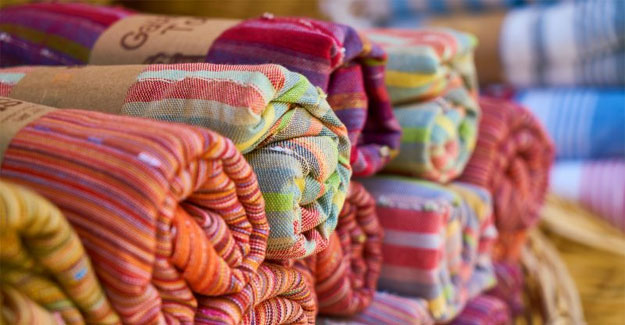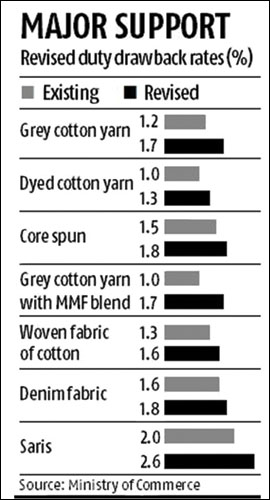
Govt Hikes Duty Drawback Rates To Boost Textile Exports
The government's decision to raise the duty drawback rates will boost textile and apparel exports, experts said.
Despite several incentives offered by the government to boost textile and apparel exports, their shipment from India stagnated between US$ 32 billion and US$ 37 billion for over seven years. For the financial year 2017-18, India witnessed textile and apparel exports to the tune of US$ 36.05 billion as against the target of US$ 45 billion. Now, the government has set yet another challenging target of US$ 82 billion by 2021.
To achieve this, the government hiked the Merchandise Export from India Scheme (MEIS) rate from 2% to 4% on various products and also offered several incentives, including interest subvention. But, these efforts did not yield desired results primarily because of preferential treatment given to small economies like Bangladesh and Thailand in the western countries.
"The revised drawback rates will lead to increase exports of cotton textiles and other products in the value chain. There is a significant increase in the drawback rates for cotton made-ups which will encourage export of value-added products like home textiles. Further, the removal of drawback cap in the case of export products where the drawback rates are less than 2% will benefit the cotton textiles exporters," said K V Srinivasan, Chairman, The Cotton Textiles Export Promotion Council (Texprocil).
The Union Ministry of Commerce raised the duty drawback rates across all varieties of textile and apparel by up to 70% recently.
Meanwhile, India's overall textile and apparel exports recorded a marginal growth of 2% to US$ 20.8 billion for the April-October 2018 period over US$ 20.4 billion in the corresponding last year. The share of textile and apparel in overall merchandise exports from India stood at 11% for the period this year.
 "The increased drawback rates will provide relief to the exporters. In view of the significant duties/taxes embedded in the man-made fibre (MMF) textile segment, the drawback rates declared now need to be enhanced at least up to 6-7% from the existing 1-3%," said Narain Aggarwal, Chairman, The Synthetic & Rayon Textiles Export Promotion Council (SRTEPC).
The increase in the duty drawback rates would help exporters face competition in the overseas market. The maximum increase of drawback rates on MMF textiles is by about 1.5%. Also, the product of nylon filament yarn (dyed) has been added under the drawback scheme.
Texprocil, meanwhile, urged the government to increase the MEIS rate for fabrics from 2% to 4% and also to cover cotton yarn under the MIES apart from a 3% increase in Interest Equalization rate so that exports of cotton textiles can achieve its true potential.
Meanwhile, apparel exporters are unhappy as duty drawback rates for cotton apparel have come down, while those for woolen apparel have been raised. The moves is aimed at giving a boost to India's exports of winter garments. India is known mainly as an exporter of summer garments, due to availability of light fabrics. Hopefully, with this move, there will be some momentum to export heavier apparel, though garmenters may have to depend on apparel wool fabric imports.
"The increased drawback rates will provide relief to the exporters. In view of the significant duties/taxes embedded in the man-made fibre (MMF) textile segment, the drawback rates declared now need to be enhanced at least up to 6-7% from the existing 1-3%," said Narain Aggarwal, Chairman, The Synthetic & Rayon Textiles Export Promotion Council (SRTEPC).
The increase in the duty drawback rates would help exporters face competition in the overseas market. The maximum increase of drawback rates on MMF textiles is by about 1.5%. Also, the product of nylon filament yarn (dyed) has been added under the drawback scheme.
Texprocil, meanwhile, urged the government to increase the MEIS rate for fabrics from 2% to 4% and also to cover cotton yarn under the MIES apart from a 3% increase in Interest Equalization rate so that exports of cotton textiles can achieve its true potential.
Meanwhile, apparel exporters are unhappy as duty drawback rates for cotton apparel have come down, while those for woolen apparel have been raised. The moves is aimed at giving a boost to India's exports of winter garments. India is known mainly as an exporter of summer garments, due to availability of light fabrics. Hopefully, with this move, there will be some momentum to export heavier apparel, though garmenters may have to depend on apparel wool fabric imports.

Textile Excellence
If you wish to Subscribe to Textile Excellence Print Edition, kindly fill in the below form and we shall get back to you with details.








